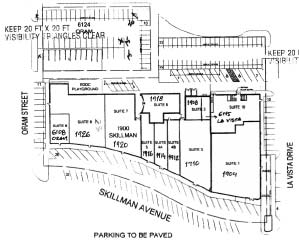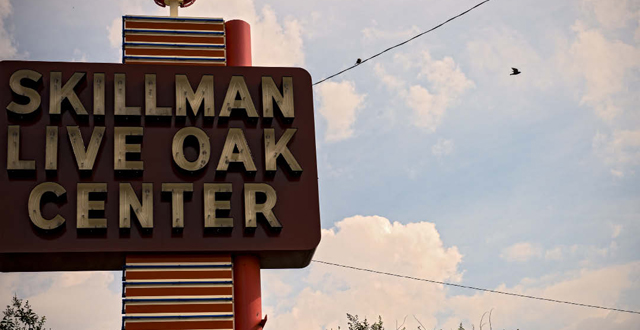There’s been a lot of buzz about the shopping center on Skillman between Live Oak and Oram, much of which was bought by Austin-based investing firm Stonelake Capital Partners a couple of years back. Seems like every time we turn around, someone else is moving out or moving in. Amid a flurry of rumors, it’s hard to pin down Stonelake’s grand plans for the place, but the surrounding neighbors have one request — for the love of Pete, no more restaurants, please.
What’s the latest?

Parking configuration for businesses between Oram and La Vista on the east side of Skillman: City of Dallas Planning
Back in December 2012, Austin-based coffee shop Houndstooth announced it would open a location in Lakewood at the southeast corner of Skillman and Oram. Houndstooth owner and Dallas native Sean Henry planned to play into the rising trend of offering local brews as well as coffee.
However, someone already occupied that particular corner: Gallery Central, a custom-framing store that had been there for 23 years.
In 2011 Stonelake Capital Partners purchased the strip of shops on the east side of Skillman between Oram and La Vista, where Gallery Central was located, as well as the old Coldwell Banker Residential Brokerage building on northeast corner of Skillman-Oram and the retail triangle at Skillman-Live Oak that houses Wine Therapist, CrossFit White Rock and The Mecca.
With Houndstooth moving in, Gallery Central owner Steffanie Smith says Stonelake told her she had to move out to make room for the new java joint.
“They were nice enough, but it was obvious this is a numbers game,” Smith said at the time.
Smith didn’t have to move far. Stonelake began preparing a spot for her behind her longtime location. It was a little out of sight, but at least it was in the same shopping center. Smith had to move out by January so Houndstooth could begin setting up shop. By February, it was obvious things were moving a little slower than planned for Houndstooth, but Gallery Central still moved out.
Smith opened in her new location in April. Visitors can access Gallery Central through the back parking lot, between Sunstone Yoga and the playground for the East Dallas Developmental Center.
“I like the space — it’s open and it’s bigger — but business has really slowed down because we don’t have the window spot on the street,” Smith says. “We were supposed to be closed two weeks, but because we had to be out over there before this one was finished, we were closed three months, so that really hurt us.”
Now, more than nine months after Houndstooth announced its plans to move to Lakewood, the location at the corner of Oram and Skillman is still coffeeless.
“It’s been very frustrating,” Smith says. “I could have been there all along; everybody would have been happy.”
So where in the world is Houndstooth? Last time we talked with Henry, in March, he said the project was on hold while he dealt with “unexpected issues,” but he wouldn’t elaborate on what the issues were. At the time, he said he was unsure of the future, although he did say he still wanted to open a Houndstooth in that location. Henry hasn’t responded to interview requests since March.
Neither has Stonelake responded to multiple interview requests, but in June, someone who answered the phone in the front office told us that “[Houndstooth] is not going in, but we have not closed them off from coming.” At press time, the former Gallery Central space still sat vacant.
Next door, at 1926 Skillman, the East Dallas Developmental Center (EDDC) is slated to move across Oram into the old Coldwell Banker building in September.
Like their neighbor, the EDDC team was asked to move by Stonelake, but this time the move is actually working in the childcare center’s favor, says EDDC spokeswoman Lexi Harper. The center is gaining extra square footage, a quiet, fenced-in play area, more parking, a safer entrance and exits for the kiddos, and a fresh start in a newly renovated building. Stonelake tried to rezone the Coldwell Banker building last year from a neighborhood service district to commercial retail zoning (which, among other things, could’ve been a restaurant, or even a fast-food chain), but neighbors intervened and put a stop to the zoning change.
Harper says the EDDC plans to move on Sept. 19, so is in the process of renovating and fundraising now.
EDDC has been a fixture in East Dallas for more than 30 years and in that time has educated hundreds of children, from 6 weeks to 5 years old. The waitlist to get into the school is long, so this expansion is much needed, Harper says.
The Wine Therapist, which has occupied the corner of Skillman and Live Oak for nine years, also is relocating. The Wine Therapist’s lease is up Oct. 31, and owner Phillip Nikpour says Stonelake raised his monthly rent to almost $10,000, so he couldn’t stay. Nikpour will move across the street into what used to be Lakewood Consignment, between Goldrush Cafe and Ralph Austin Jewelers. Stonelake does not own the strip of shops on the west side of Skillman.
If all goes as Nikpour plans, the Wine Therapist will re-open in November, but first Nikpour has to make a few renovations to the building, which he says is a “really lovely space with a wrought-iron railed staircase and high ceilings.”
Finally, Chip’s Hamburgers is opening in the building behind Matt’s Rancho Martinez in what used to be Paperbacks Plus. Chip’s co-owner Brent Gampster says the family-owned, Dallas-based restaurant chain hopes to open the new Lakewood location sometime in mid-September.
The layout of the restaurant is going to be significantly different than any of the other Chip’s, Gampster says.
“This is the first time we’ve gotten to design a building that was really just a shell,” he says. “In all the other places, we’ve gone into what was already a restaurant, so we had to work with that. To me, it’ll be a little more upscale but still have a lot of the same features that we’re known for.”
There will be an open kitchen where people can talk with the cooks, like at existing Chip’s locations, but the space on Skillman and La Vista will allow Chip’s to offer more of a cafe-style eating area with big windows, multiple TVs and a full bar.
This location also will feature a separate dessert area where Chip’s will serve pies, sno-cones and, of course, its signature milkshakes.
Chip’s also hopes to put in a patio along La Vista, Gampster says. And like the Chip’s location on Lovers, this one will have a game room for the kids, but instead of being crammed in the front, there’s a separate room for it tucked away in the back.
Gampster says he is working hard to preserve the integrity of the building.
“Even those windows that are coming out with the bookstore stuff on them, we’re going to try to incorporate those on the inside,” he says. “You’ll still see the red granite and stuff on the outside; all that will stay. We want to keep that Lakewood history inside the building.”
If you build it, they will come
New restaurants inevitably are followed by an influx of parked cars, which is the concern of surrounding neighbors. The Skillman Live Oak Center parking lot is busy enough as it is, so the thought of more restaurants in the area is cringe-worthy, says nearby neighbor Olive Talley.
“We’re looking at Lower Greenville and the parking issues they have, and we don’t want that,” Talley says.
With Houndstooth MIA and the EDDC moving, that leaves a whole lot of potential restaurant-ready space. Talley says she has attempted to reach Stonelake several times to ask about plans for the space, with no success.
Nikpour says Stonelake has shown the Wine Therapist space to restaurants and other wine bars, although so far none has been interested in the space for the price Stonelake is asking.
Trey Knowles, a practicing manager with Metro Paws, says the veterinarian office is extremely nervous about the thought of more restaurants coming to the shopping center, especially since they already struggle with the current parking setup.
“With restaurants, people come for an hour or more and stay, and they bring in people from all over who maybe aren’t as understanding of our situation,” he says.
“We had a lady the other day who had an emergency and drove around the building four times and finally called and said, ‘I’m in your back parking lot. I’ve got a cat that’s really sick, and I can’t find a parking spot,’ so we just brought her in the back.”
Not only does the front parking lot fill up during dining hours; sometimes the back parking lot gets full, too, Knowles says, and when Chip’s moves in, that will increase traffic in the back even more.
“The traffic kind of comes and goes. Sometimes they’re busy, sometimes they’re not,” Knowles says, “but as a business, it does make us nervous about the possibility of even more long-term parking.”
Nearby neighbors insist the parking lots are overextended, but according to City Planning, Stonelake is perfectly within its legal rights. Granted, the process that got it there couldn’t be more complicated, says Frances Estes, a senior development coordinator with the City of Dallas.
“If someone came to us today with this parking layout, we wouldn’t let them build this,” Estes says.
So how does Stonelake get away with it? It utilizes three primary tactics: delta credits, shared parking spaces and remote parking.
The most complicated of the three is delta credits. When the Skillman Live Oak shopping center was built in the 1940s, there were no parking requirements. Years later, when the city began enforcing parking requirements, it employed a system in which certain businesses had to prove they could provide more parking than others. For example, restaurants require more parking than retail, which require more parking than offices.
To protect businesses in older shopping centers such as Skillman Live Oak, the city granted delta credits, which are essentially imaginary parking spaces, to fill the gap between the physical parking spaces and the parking requirement. Those delta credits have carried on through the decades — although some credits have been lost during business changes, and once delta credits are lost they can never be recovered.
Stonelake also uses shared parking options, which means if one business closes at 5 or 6 p.m. and another reaches peak parking after 6 p.m., then they can share parking spaces. Whether or not this system actually works out for the businesses in reality is up for debate, but as far as the city is concerned, it’s code-compliant.
Finally, Stonelake uses a remote parking lot for the triangle where Wine Therapist and the Mecca are housed — a parking lot off Live Oak provides 22 spaces. It’s important to note that City Planning doesn’t count parking spaces that back up into the street in their parking count, so dozens of the spaces people use regularly are not included in the required parking count.
But the real question is, can Stonelake bring in more restaurants? That’s what neighbors such as Talley want to know.
According to the current parking arrangement, Stonelake is maxed out, Estes says. The buildings on the east side of Skillman have exactly as many parking spaces as the city requires for such a tenant mix.
Parking-wise, the EDDC space is listed as a child care facility, which requires very little parking, and the Wine Therapist as a liquor store, which also requires very little parking. So in order to put in a restaurant in either location, Estes says, Stonelake would have to prove they can provide additional parking for higher traffic businesses.
However, it wouldn’t be impossible.
“They would have to go through the appropriate measures,” Estes says, “but we don’t know; they could. There’s so many ways that businesses can meet code requirements. If they make it work and it’s compliant with code, we’re required to issue them a permit. We can’t go, ‘Well, the neighbors don’t like you.’ ”






